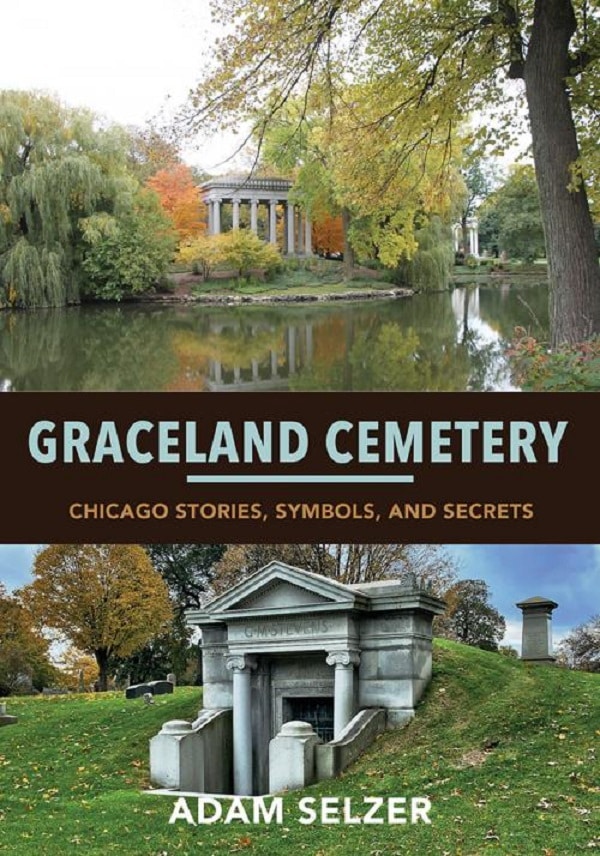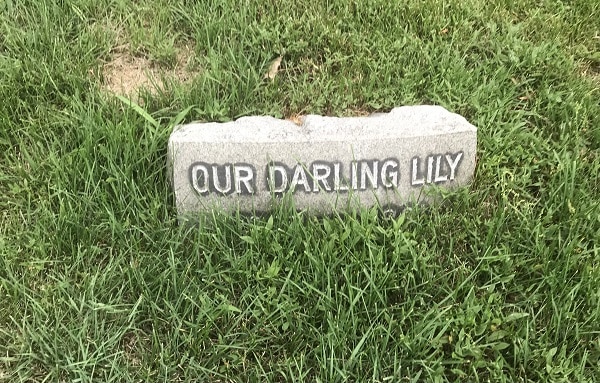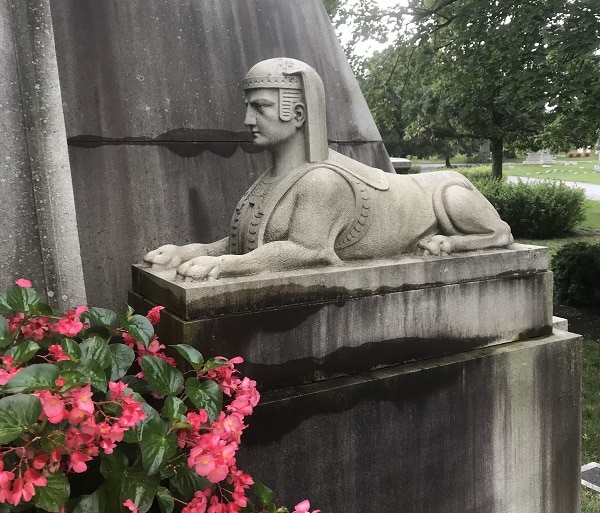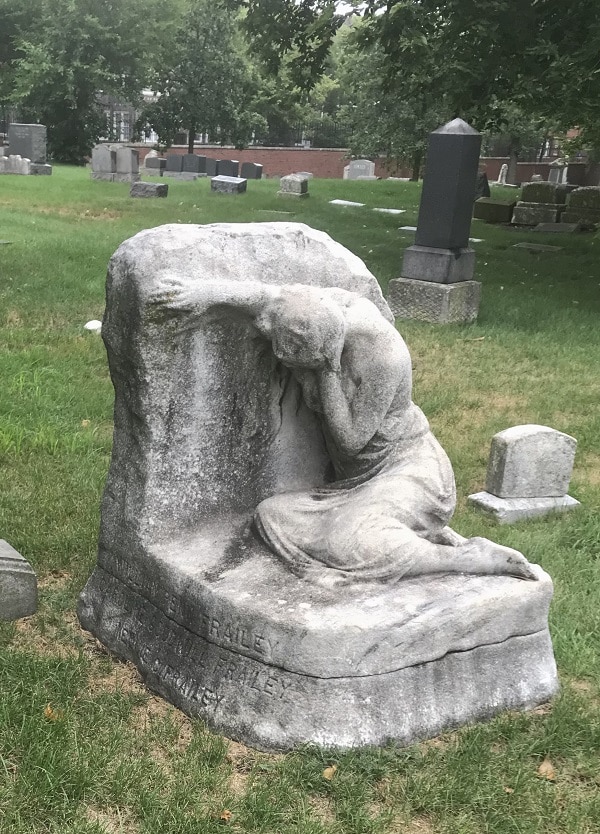Near the end of my hourlong walk around Graceland Cemetery the other day, I went past a stone obelisk, maybe 30 feet tall, and noticed this on the side:
SANDRA E. RITTER
NOV. 22, 1952
NOV. 27, 1952
SUSAN E. RITTER
NOV. 22, 1952
The November date is what caught my attention first because I was born on November 22, three years earlier. Then, looking more closely, I realized these dates told a sad story.
I can’t be sure, but my best guess is that Sandra and Susan were twins, born on November 22. Susan died that day, and Sandra lived for only five days. Later, the grieving parents had these two babies memorialized on the side of the family gravesite obelisk.
It’s possible that, if I looked hard enough and in enough places, I might find out if my guess is right, but, really, it would be a stretch to expect to find much, if any, information.
This is an example of the unanswerable ambiguity of much of what I find when, as I often do, I walk Graceland Cemetery or Rosehill Cemetery or some other cemetery wherever I happen to be. What was the full story of Sandra and Susan Ritter? I’ll never know. All I know are a few words and numbers carved in stone.
A guidebook and serendipity

I was out that day at Graceland with a copy of a new book by Adam Selzer, Graceland Cemetery: Chicago Stories, Symbols, and Secrets from University of Illinois Press. It’s a book that was well-reviewed by my Third Coast Review colleague Dan Kelly.
Richly researched, it offers the reader ten walking tour routes in the cemetery, providing the stories behind some of the gravesites that are found along the way. Selzer goes out of his way to find interesting, if sometimes obscure, people to highlight on these routes. He gives a nod to the most famous of the monuments but is much more interested in those of lesser-known men and women. After all, the vast majority of the estimated 175,000 folks buried at Graceland weren’t high-profile figures.
I applaud Selzer for putting the book together, and I brought it with me to Graceland. But, right away, I recognized that his approach to the cemetery is much different from mine.
The Graceland visitor who takes along Selzer’s book is treated to factual accounts of who this person or that person was, such as the three paragraphs on “Captain George Wellington Streeter: The Pirate King of Chicago,” a colorful squatter who gave his name to Streeterville, east of Michigan Avenue.
It’s a guidebook, crammed with such carefully documented stories. And an interesting way to learn more than a bit about Chicago’s history. Selzer spends much more of his time discussing the lives these people lived than how their grave memorials look.
Standing in Graceland with Selzer’s book, I decided that I’m not a guidebook kind of a guy.
For instance, I’ve been to Père Lachaise Cemetery in Paris three times and, unlike the vast majority of American visitors there, have never tried to find Jim Morrison’s grave there. Instead, I just start off in one direction, looking for odd and interesting tombs — the place is chock-full of them — and let serendipity bring me whatever it will bring. That’s what I do at every cemetery, and it’s what I did the other day at Graceland.
Like an IBM Selectric typewriter ball
Selzer’s ten walking tour routes are basically along Graceland’s roads. My approach, though, is to park my car near something that catches my eye and then head off across the grass and leave the roads behind.
The other day, I parked near a tall marker because the green oxidized-bronze globe atop it reminded me of the typing ball that was the key feature in the IBM Selectric typewriter in its heyday from 1961 through 1984. (For those of you under the age of 40, let me tell you it was, for the time, the coolest thing.)
The marker is for the gravesite of architect Howard Van Doren Shaw, and it’s listed by Selzer in his book. It was clear that the letters on the globe weren’t the scrambled-up alphabet of the Selectric ball but formed words of some sort.
Selzer doesn’t mention the words in his book, but with a lot of neck-craning, I figured out that they were the six-verse Psalm 23, beginning, “The Lord is my shepherd…” Why that psalm? Who can say?

Sorrow soaked in the soil
From there, I started across the lawns, and, for whatever reason, I was noticing a lot of graves for infants: “Our Darling Lily,” and “Our Darling Carol Moizo/July 13, 1948,” and “George C. Gilbert/Died Nov 15 1876/Aged 21 mos.”
There was a heart-breaking near-life-size sculpture of a weeping woman, made more touching by the way the weather had worn the stone to a rounded softness.
It’s richly evocative of the sorrow that is soaked into the soil at Graceland or any cemetery, and it was particularly striking for me after noticing so many graves of babies.
In his book, Selzer calls this the Frailey-Watson Monument, and he explains that, on July 13, 1879, Mary Frailey Watson lost her sister Nellie, about 20, to tuberculosis and her son, Willie, apparently a baby, to cholera infantum. Many years later, Mary hired sculptor Nellie Verne Walker to create this monument.
A dopey-looking sphinx
My wanderings at Graceland that day, however, weren’t just about sad stuff.

At one point, I found myself at the visually arresting dark-stone pyramid of brewer Peter Schoenhofen. I checked Selzer’s book, and he has four paragraphs on the odd mix of religious symbols that were worked into the mausoleum.
I was struck, as I always am, by the bland, puny and dopey-looking sphinx to the right of the monument entrance. In contrast to the life-size angel to the left, this sphinx seems like as fairly harmless dog with an insipid human head. What was Schoenhofen thinking?
I also wondered about what the Stone family was thinking regarding the tomb marker for Henry Baldwin Stone (died 1897) and Elizabeth Mandell Stone (1907). It’s a large stone.
In fact, during my walk, I spotted several large stones (or small boulders) that were serving as grave markers, the most famous of which is for Daniel Burnham on a small island with other family markers.
I’ve seen this Burnham boulder many times, and it’s always seemed ironic to me that such a rough and natural lump of stone would commemorate the man who preached, “Make no little plans,” and who oversaw the World’s Columbian Exposition of 1893, the height of modernity at the time, and who, with Edward Bennett, promulgated The Plan of Chicago in 1909, a blueprint for giving human order to the chaotic natural landscape.
Maybe a bit of a guidebook guy
Clomping across the Graceland lawns, at one point, I spotted something I’d never seen before in my many trips to the cemetery — a gravestone with the name “MANUEL” and, seated on the top of the marker, a bit to the left, the statue of a boy playing a flute.
Selzer writes that it is a monument to Christopher D. Manuel, a Rush Medical Center anesthesiologist who died in 2005 in his early 40s. Also buried there is his mother Linda who died in 2007.
This was one of many times during my walk when Selzer’s book was able to answer questions my wanderings had raised, so maybe I was at least a little bit of a guidebook guy.
That was on my mind when I got back to my car near the Shaw gravesite, and, then, I noticed that, a few feet away, the tall, imposing Hoyt family monument.
Talk about a sad story. It’s one I’ve known a long time.
The Fox family
On one of my first visits to Graceland, I noticed this tall monument, topped by a woman pointing to heaven. But what caught my attention were five small grave markers, all in a row in the back.
Four of them had the same date of death: Emilie Lydia Hoyt Fox, 36; George Sidney Fox, 15; William Hoyt Fox, 12; and Emilie Lydia Fox, 9. That day was December 30, 1903, the day of the Iroquois Theatre Fire which killed some 600 people and the four members of the Fox family.
And one more: Frederick Morton Fox, the husband of Emilie and the father of the three children, who died 63 days later. A Chicago Tribune report on his death, cited by Selzer, notes that the loss of his entire family left Frederick Fox “shattered in health.”
Cemeteries remind us of the lives that people once led, and this is the aspect that Selzer emphasizes in his richly detailed book.
But, even more, cemeteries are about sorrow and loss and remind us of what we — each and every one of us — have before us. Yeah, sad stuff.

Patrick T. Reardon
8.23.22
This essay originally appeared at Third Coast Review on 8.17.22.
Written by : Patrick T. Reardon
For more than three decades Patrick T. Reardon was an urban affairs writer, a feature writer, a columnist, and an editor for the Chicago Tribune. In 2000 he was one of a team of 50 staff members who won a Pulitzer Prize for explanatory reporting. Now a freelance writer and poet, he has contributed chapters to several books and is the author of Faith Stripped to Its Essence. His website is https://patricktreardon.com/.
